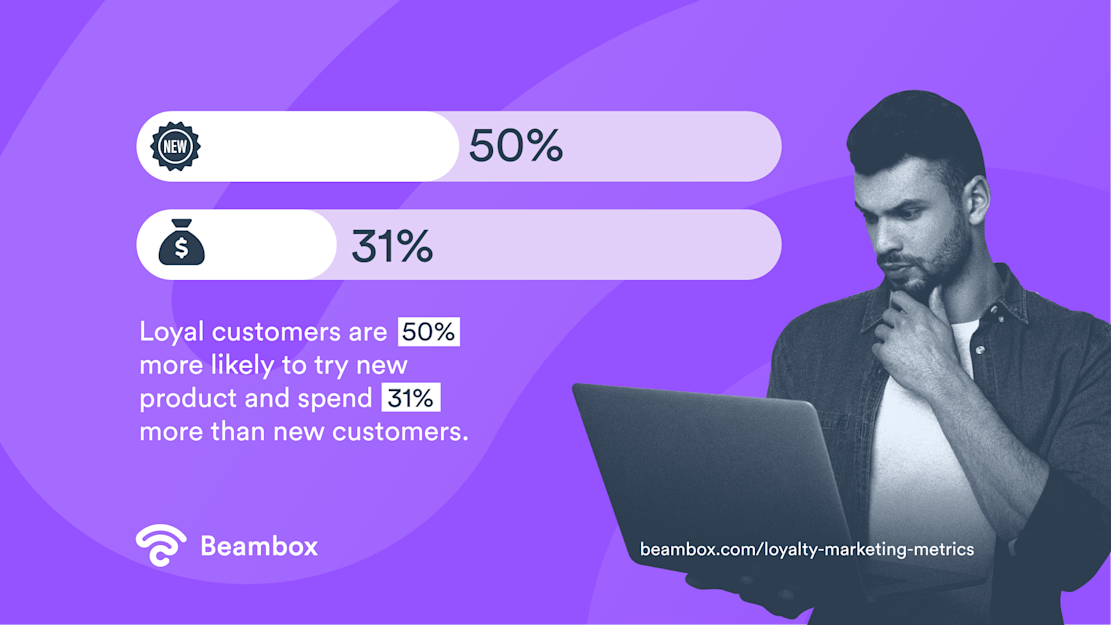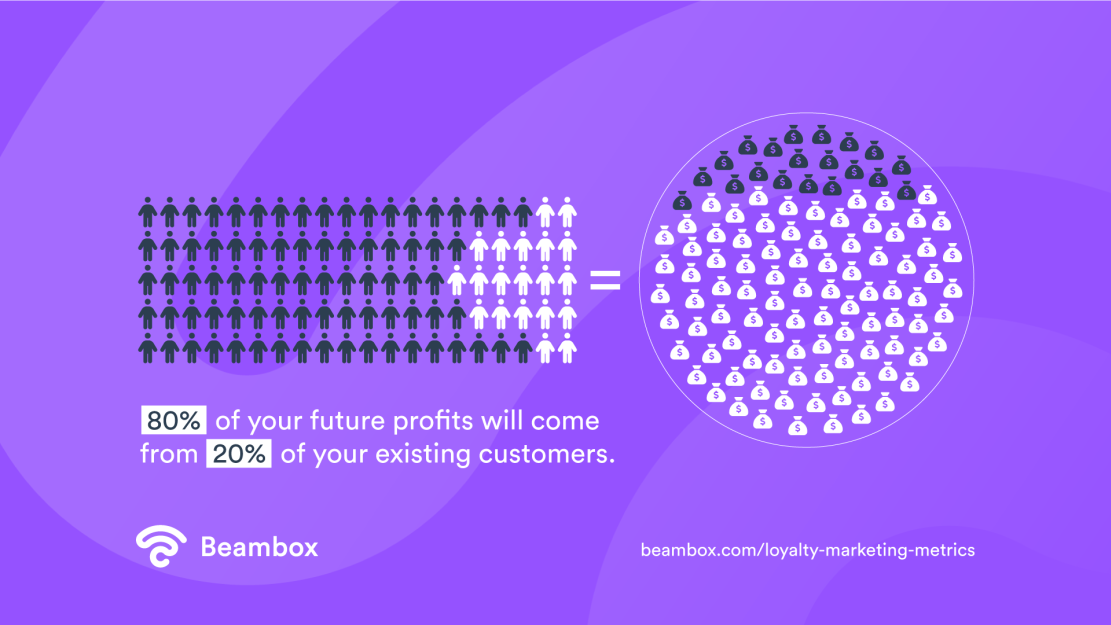Loyalty marketing metrics measure and quantify the loyalty of customers to your business.
Simply put, if you figure out what makes your customers loyal to your business, you will keep them coming back.
Moreover, loyalty marketing metrics help you identify areas where you may need to re-evaluate your marketing strategy.
In this article, we will guide you through the most important loyalty marketing metrics to grow your business by building a loyal audience of customers.
What is Customer Loyalty and Why Does It Matter
There is no single, universally accepted definition of customer loyalty. However, it can be defined as a strong emotional connection between a customer and a business or a brand.
This connection can be based on factors such as satisfaction, trust, commitment, and value alignment.
Let’s be clear. Customer loyalty is paramount for any business, regardless of its industry or dimension.
When customers are loyal to a business, they are more likely to return for future purchases and to recommend the business to others.
In turn, businesses that earn customer loyalty can enjoy increased sales, reduced marketing costs, and higher profits.
According to Forbes, loyal customers are 50% more likely to try new products and spend 31% more than new customers.

Additionally, loyal customers are the natural advocates of your business and will bring new customers on board.
Now that we have defined customer loyalty and why it matters for your success, let’s see how to find the loyalty marketing metrics that you want to track.
To track your customer’s loyalty there are a variety of metrics and tools.
These will help you assess how your business is valued by the customers, what they like and value the most, and whether they will recommend it.
The metrics listed below are the most relevant for small businesses. However, not all of them can be defined through percentages.
In fact, human beings are not numbers thus few relevant indicators cannot be tracked and written on a spreadsheet.
Some critical metrics can only be noticed through your eyes as they truly reflect the behavior of your customers.
Let’s jump into the metrics
Customer Retention
Have you ever heard of the Pareto Principle?
It states that 80% of your outcomes come from 20% of your effort.
Unsurprisingly, a study conducted by Gartner Group showed that 80% of your future profits will come from 20% of your existing customers. Loyal customers.
Moreover, the probability of selling to an existing customer is way higher than selling to a new one.

To measure Customer Retention, also called Repetitive Purchase Rate (RPR), you have to divide the number of customers who made a repeat purchase in a given timeframe by the total number of customers in the same timeframe.
However, this metric can be hard to precisely measure without a dedicated tool (e.g. Loyalty cards, registered profiles, etc.).
Nonetheless, if your business is small-medium size, you should be able to recognize how often people come back to visit your venue.
The best way to keep customers coming back?
Give them an exceptional experience each and every time they interact with you.
This means providing great customer service, delivering on your promises, and going above and beyond when possible.
Additionally, keep them engaged. Send them communications regularly (but not too often) that interest them and add value. SMS marketing can be brilliant for this purpose
Customer Satisfaction metrics
In order to ensure customer satisfaction, small businesses have to understand what their customers want and need.
Many factors can influence customer satisfaction, such as the quality of the product or service, the price, the delivery time, how well the customer was treated, and how well the customer’s needs were met.
According to Gartner Group, companies that prioritize the customer experience generate 60% higher profits than their competitors.

One way to measure customer satisfaction is through the Net Promoter Score (NPS).
Net Promoter Score is a type of survey that aims to measure how likely your customers are to recommend your business in their social circle.
In an NPS questionnaire, your customers will be asked to pick a number between 0 to 10 on a batch of questions related to their experience with your business.
The questions can touch on a wide range of topics such as overall satisfaction with a product or service, quality of products or services, the likelihood of recommending a product or service to others, and reasons for any dissatisfaction.
Customers that give a 9-10 to most questions are so-called Promoters. Those customers that pick a score between 0-6 are Detractors. Finally, those that pick 7 or 8 are Passive.
The limit of the NPS is that it measures the intent of your customers and not their actual behavior. However, you can integrate it with the behavioral metrics listed below.
Businesses should also listen carefully to customer complaints and negative reviews in order to identify areas where they need to improve.
By understanding what customers want and addressing any issues that may cause dissatisfaction, businesses can increase customer satisfaction and boost sales.
Upsell Ratio
The upsell ratio is **the percentage of customers who buy an additional product or service **after their initial purchase.
For example, if 10% of your customers buy an add-on product or service after their initial purchase, your upsell ratio is 10%.
There are a few things you can do to improve your upsell ratio.
First, make sure you have a variety of products and services to offer your customers. This will give them more options and make it easier for them to find something that’s right for them.
Second, make it easy to purchase the additional service or product.
Upsell indicates that your customers value your business and regard your products and services with trustworthiness.
Likes, shares, and comments are often seen as the most important metrics to measure your success on social media and in the real world. However, these metrics became meaningless the moment it was possible to purchase them.
Nonetheless, if you are a small business owner you should consider the level of engagement your social media post-receive.
When genuine (and coming from authentic profiles), likes, shares, and comments prove that your audience is interested in your work and value what you have to say.
This will also prove that they have a close relationship with your brand and will likely promote your business via word-of-mouth.
Positive Reviews
Along with being one of the most powerful ways for a business to stand out, positive reviews are also indicative of an excellent experience.
Somehow, writing a negative review is perceived as a duty while writing a positive review is often regarded as unnecessary.
When someone takes the time to write a positive review, it often means that the experience was worth recommending.
Just like social media interactions, it is never wise to buy fake reviews because you can’t outrun a bad experience.
However, take pride in positive reviews and acknowledge them as an indicator of success.
Bringing family and friends
Humans want to look good.
Especially in the eyes of those they love.
That’s why the most important signal that your customer appreciate your work is bringing their loved ones to your venue.
No statistical indicator can prove the loyalty to your business more than sharing it with family or friends. Thus, watch out for these signals and ensure that their decisions won’t pass unnoticed.
Conclusion
Measuring customer loyalty is an important metric to assess the reliability of your business.
As studies show, loyal customers represent the time the main source of income for most businesses in the long run.
You can also consider implementing a loyalty program to leverage and reward your loyal customers.
Additionally, you can increase the number of your true fans by using our simple marketing strategies
However, don’t forget, the most important thing is always one.
Caring.
If you truly care about your customer, you will be inevitably rewarded.